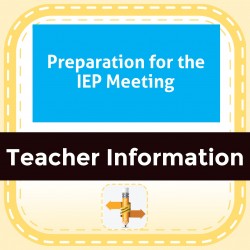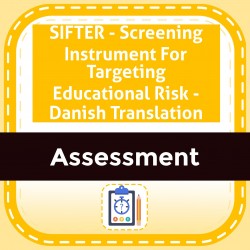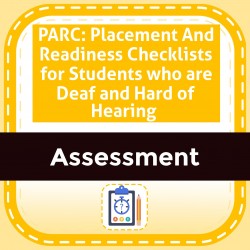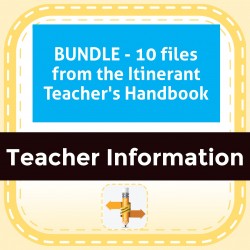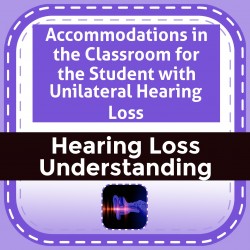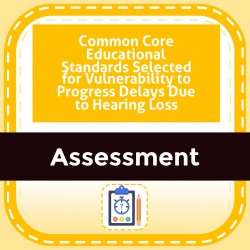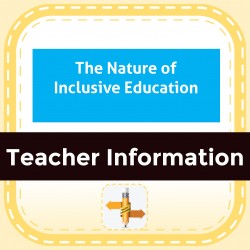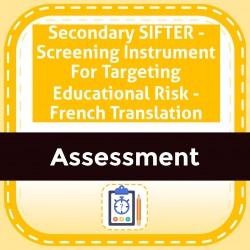Ability Levels
Categories
Resource Types
Age/Grade Range
CCSS
Anchor Standard
Speaking & Listening
Language
Reading
Student Friendly Adapted SEAM
$ 7
The ADAPTED SEAM uses student-friendly language that activates self-reflective skills, encourages student ownership, and provides an interactive/conversation starter when done with the student. Some s
...
tudents experience an "ah-ha moment" about their responsibility the first time they complete the chart.
Ways To Use This:Discussion tool while completing the data form with your student. Self-reflection tool for older students while providing data for you.Assessment tool for determining self-advocacy present levels. (sample write-up included)Baseline data for your measurable IEP goal. (sample goal included)Students To Use This With?A student who is missing many of these skills at their levelsA student who is NEW to hearing devices regardless of age. An older student needing frequent reminders of these skills can benefit from revisiting the form periodically to track their progress.Why Use this?Editable PDF or Printable (2 versions)Timely benchmarks for progress reportingEasily Attach/Upload to IEP SystemsSample Assessment/Present Level Write-Up provided Sample IEP Goal & Completed Student Example providedWhat's Included in this Adapted SEAM Product?Overview of All Adapted Levels At a Glance (1 page) Directions and Ways To UseEditable PDFs - compact, single-page view. (7 forms/levels: Pre-K, K, 1st-2nd, 3rd, 4th, 5th, MS/HS)Printable Forms - expanded onto 2 sides for reading and writing ease. (7 forms/levels: Pre-K, K, 1st-2nd, 3rd, 4th, 5th, MS/HS)Student Data Example Sample Assessment/Present Levels Write-UpSample IEP goalSample - Real Student Form Completed over an IEP year.
Preparation for the IEP Meeting
$ 0
This is information for parents to consider as they develop the IEP. From www.agbell.org.
SIFTER - Screening Instrument For Targeting Educational Risk - Danish Translation
$ 0
Danish Translation - The Screening Instrument For Targeting Educational Risk (SIFTER) was created as a tool to screen the functional performance of students with hearing loss in secondary school (ages
...
12-18). It includes a scoring grid to identify areas of concern.
PARC: Placement And Readiness Checklists for Students who are Deaf and Hard of Hearing
$ 0
Suite of checklists: 1) General Education Inclusion Readiness Checklist, 2) Interpreted / Transliterated Education Readiness Checklist, 3) Captioning / Transcribing Readiness Checklist, 4) Instruction
...
al Communication Access Checklist, 5) Placement Checklist for Children who are DHH Preschool / Kindergarten, 6) Placement Checklist for Children who are DHH Elementary, 7) Placement Checklist for Children who are DHH Secondary.
BUNDLE - 10 files from the Itinerant Teacher's Handbook
$ 2595
This bundle includes 10 files from The Itinerant Teacher's Handbook: 1) Potential Impact of Hearing Loss, 2) Collaborative Relationships, 3) Life Balance, 4) Collaborative Teamwork, 5) Making Inclusio
...
n Work, 6) Promoting Language and Literacy, 7) Helping Parents Communicate, 8) Promoting Social Skills, Friendships, Self-Advocacy, 9) Assessment Issues, 10) Planning Transitions. Save 33% over purchasing all 10 separately. NOTE: Printed book is available for $59. P05TEA0426-435)
Accommodations in the Classroom for the Student with Unilateral Hearing Loss
$ 0
This one-page handout for DHH professionals describes information to be shared with classroom teachers who have students with unilateral hearing loss.
Common Core Educational Standards Selected for Vulnerability to Progress Delays Due to Hearing Loss
$ 195
This checklist lists the common core educational standards that were selected for vulnerability to progress delays due to hearing loss. The skills listed should be age appropriate when a child is list
...
ening in the presence of typical classroom noise and across classroom distance. Standards for students in kindergarten, grades 3 and 6 are included for speaking & listening and reading fundamentals. Features a comparison grid to visualize the relative normality of results across the selected standards. Fillable.
The Nature of Inclusive Education
$ 6
Choosing the most appropriate school for a child requires collaboration between the parents and the school. Together, they should decide which will be the best option for the child. This module define
...
s the concept of inclusive education, as well as the barriers which a child with hearing loss could experience. However, these barriers can be overcome through an attitude of determination, with ongoing training and self-enrichment on the part of the teacher and the broader community. Overcoming the barriers is imperative for inclusion to be successful. Inclusive education starts with parents advocating for their children with school management.Inclusion exposes a child with hearing loss to individualized teaching strategies. It requires additional support from family and the school team, which usually includes the classroom teacher and the teacher of the deaf/hard of hearing and may also include the speech-language therapist and other special education support staff in the child’s school.The purpose of inclusive education is to ensure that all children gain access to knowledge and skills that will make them socially and economically independent. The main requirement for inclusion is that the school must be willing to accept the challenge and adapt.
SIFTER - Secondary Screening Identification for Targeting Educational Risk - User's Manual
$ 0
The Screening Instrument For Targeting Educational Risk (SIFTER) was created as a tool to screen the functional performance of students with hearing loss in preschool in preschool, elementary and seco
...
ndary school and includes a scoring grid to identify areas of concern. This User Manual focuses on secondary students and will explain the background, development, validity, effectiveness and reliability of the SIFTER.
Secondary SIFTER - Screening Instrument For Targeting Educational Risk - French Translation
$ 0
French Translation - The Secondary Screening Instrument For Targeting Educational Risk (SIFTER) was created as a tool to screen the functional performance of students with hearing loss in secondary sc
...
hool (ages 12-18). It includes a scoring grid to identify areas of concern.
 Your browser is out of date. For best experience switch to latest updated Browser.
Your browser is out of date. For best experience switch to latest updated Browser.
 Get Chrome
Get Chrome Get Edge
Get Edge Get Firefox
Get Firefox
